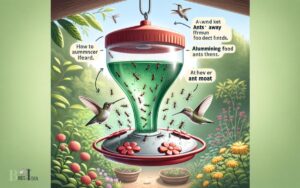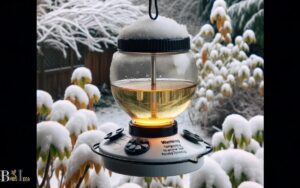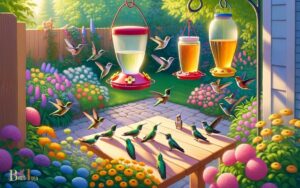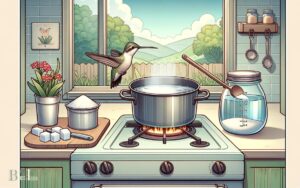How Do Hummingbird Feeders Work? Find Out!
Hummingbird feeders work by mimicking the natural feeding sources of hummingbirds flower nectar.
These feeders are designed to dispense a sugar solution that the birds can access through feeding ports, often equipped with perches for the birds to rest on while they feed.
They include bright colors to attract the hummingbirds and are typically made of glass or plastic for easy cleaning and refilling.
Hummingbird feeders function based on a few key elements:
Example: A typical hummingbird feeder might have a red base with several feeding ports, a clear reservoir to monitor nectar levels, and a built-in ant moat to keep the nectar clean for the birds.
The Below Table about Hummingbird Feeder Features and Functions:
| Feature | Purpose |
|---|---|
| Nectar Solution | Imitates flower nectar |
| Bright Colors | Attracts hummingbirds |
| Feeding Ports | Provides access to nectar |
| Perches | Allows birds to rest |
| Ant Moats | Prevents ant contamination of the nectar |
Attract hummingbirds to your garden with a feeder that’s a beacon of nourishment and a spectacle of avian grace.
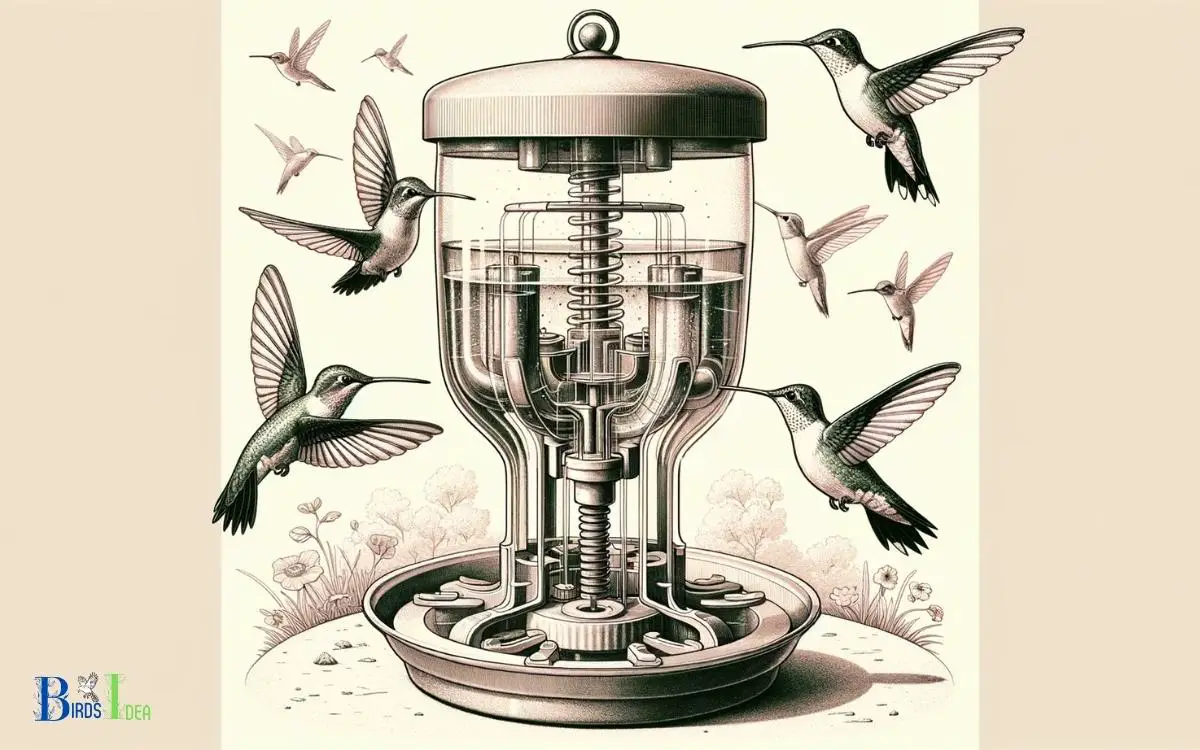
Key Takeaway
Hummingbird Feeder Design
The design of a hummingbird feeder plays a crucial role in attracting and accommodating these tiny, high-energy birds.
The feeder should have bright, eye-catching colors to attract hummingbirds, as they are naturally drawn to vibrant hues.
It should also feature perches for the birds to rest while feeding, as they have high metabolisms and need to conserve energy.
The feeder’s nectar ports should be small to prevent bees and other insects from accessing the nectar, while the shape of the feeder should allow for easy cleaning and refilling.
The material of the feeder should be durable and easy to maintain, such as glass or plastic. Overall, a well-designed hummingbird feeder not only attracts these delightful birds but also provides a safe and comfortable feeding experience for them.
Attracting Hummingbirds
Attracting hummingbirds to your feeder requires careful consideration of the nectar you use and the placement of the feeder.
Choosing the right nectar, such as a simple sugar solution, and placing the feeder in a visible, easily accessible location are key to attracting these tiny, vibrant birds to your yard.
Understanding these points will help create an inviting environment that entices hummingbirds to visit your feeder.
Choosing Right Nectar
Selecting the appropriate nectar is crucial for effectively attracting hummingbirds to your feeder.
To ensure you are providing the best nectar for these delightful birds, consider the following tips:
- Nectar Concentration
- Aim for a nectar solution with a concentration of around 20-25%. This closely mimics the sucrose content found in natural flower nectar and is preferred by hummingbirds.
- Avoid using nectar with a concentration higher than 25%, as it can be harmful to hummingbirds and may deter them from visiting your feeder.
Placement for Visibility
Effective placement of hummingbird feeders is vital for consistently attracting these delightful birds to your outdoor space.
To maximize visibility and attract hummingbirds, position the feeder near bright, colorful flowers or in a shaded area with a clear line of sight.
Hummingbirds are drawn to vibrant colors, so placing the feeder near red, orange, or pink flowers can increase its visibility.
Additionally, avoid placing the feeder near windows or reflective surfaces that could confuse or injure the birds.
It’s important to ensure that the feeder is easily visible from various vantage points in your yard, making it convenient for the hummingbirds to locate.
By carefully considering the placement of your hummingbird feeder, you can create an inviting environment that encourages frequent visits from these enchanting creatures.
Feeding Mechanism
Hummingbird feeders utilize a specialized feeding mechanism that allows these tiny birds to access and consume nectar efficiently.
This mechanism consists of the following components:
- Perches: Some feeders are designed with perches for hummingbirds to rest while feeding. The perches provide a comfortable spot for the birds to land, rest, and access the nectar.
- Feeding Ports: These are small holes or tubes from which the hummingbirds access the nectar. The design of the feeding ports prevents leakage and ensures that the nectar is accessible to the birds without spilling.
Nectar Composition
Frequently, nectar composition plays a crucial role in attracting and sustaining hummingbirds at feeders.
The ideal nectar solution mimics the natural nectar found in flowers, which is approximately 21-23% sucrose.
To create a homemade nectar solution, mix one part ordinary white granulated sugar with four parts water.
It is essential to avoid using honey, artificial sweeteners, or food coloring, as these can be harmful to hummingbirds.
The nectar solution should be replaced every 2-3 days, especially in warmer weather, to prevent fermentation and the growth of harmful bacteria that could sicken the birds.
Understanding and maintaining the appropriate nectar composition is vital in providing a safe and inviting environment for hummingbirds to feed and thrive.
Feeder Maintenance
Proper maintenance of hummingbird feeders is essential for the health and well-being of these delicate birds.
This involves regular cleaning of feeding ports to prevent mold and bacteria buildup, as well as inspecting the feeder for any signs of mold.
Changing the nectar regularly is crucial to ensure its freshness and to prevent spoilage.
Cleaning Feeding Ports
To maintain optimal functioning of hummingbird feeders, regularly clean all feeding ports with a mild soap solution and a small brush.
Here are some tips to help you enjoy the process of cleaning feeding ports:
Create a Cleaning Routine:
- Establish a regular schedule for cleaning the feeding ports to ensure that they remain free from mold, dirt, and debris.
- Consider incorporating the cleaning of feeding ports into your weekly or bi-weekly gardening routine.
Use the Right Tools:
- Invest in a small brush specifically designed for cleaning hummingbird feeder ports.
- Avoid using harsh cleaning chemicals and opt for a mild soap solution to clean the ports effectively and safely.
Inspecting for Mold
Regularly inspecting the feeding ports for mold is crucial for ensuring the proper maintenance of hummingbird feeders. Mold can pose a health risk to the hummingbirds and affect the quality of the nectar.
To inspect for mold, carefully disassemble the feeder and check the feeding ports, the interior surfaces, and any crevices for signs of mold growth.
If mold is present, thoroughly clean the affected areas with a solution of white vinegar and water, or use a mild bleach solution, ensuring all traces of mold are removed.
Consider investing in feeders with removable parts that are easy to clean, as this can help prevent mold growth and simplify maintenance.
Regular inspections and cleaning will help maintain a healthy feeding environment for the hummingbirds.
Changing Nectar Regularly
After inspecting for mold and ensuring proper cleaning, the next crucial step in feeder maintenance is changing the nectar regularly to provide a fresh and healthy feeding environment for the hummingbirds.
Frequency:
Change the nectar every 3-4 days in hot weather and every 6-7 days in cooler temperatures to prevent fermentation and bacterial growth.
Technique:
When changing the nectar, thoroughly clean the feeder with a solution of hot water and vinegar, rinse it well, and refill with fresh nectar to maintain the health of the hummingbirds.
Regularly changing the nectar not only ensures the hummingbirds have access to fresh food but also helps in maintaining the feeder’s hygiene, ultimately contributing to the well-being of these delightful creatures.
Predators and Protection
Hummingbird feeders incorporate protective features to deter predators and ensure the safety of the visiting birds.
These feeders are designed to provide a safe haven for hummingbirds while they feed, protecting them from potential threats.
Here’s a table illustrating some common predators and the protective measures incorporated in hummingbird feeders:
| Predator | Protective Measure |
|---|---|
| Insects | Bee guards and ant moats |
| Larger birds | Perches that are too small for them |
| Squirrels | Baffles to prevent access |
Can Hummingbirds Still Use Feeders If I Don’t Have One?
Hummingbirds can indeed feed without a feeder efficiently. Although they are highly attracted to feeders, they have various natural food sources they rely on, such as nectar from flowers and insects. However, if you want to feed hummingbirds without a feeder efficiently, consider planting a diverse selection of nectar-rich flowers in your garden to provide them with the sustenance they need.
Environmental Considerations
In considering environmental factors, the design of hummingbird feeders takes into account the necessity of providing a safe and sustainable feeding environment for these delicate birds.
This includes considerations such as:
Materials:
Hummingbird feeders are often made of glass or plastic to ensure they are durable and safe for the environment.
Using materials that are easy to clean and maintain helps to prevent the growth of harmful bacteria that can threaten the well-being of the hummingbirds.
Placement:
Proper placement of hummingbird feeders is crucial for the birds’ safety. Feeders should be positioned away from windows to prevent collisions and in areas where the birds have easy access while being protected from predators.
Placing them near natural food sources can provide supplementary nutrition and reduce the environmental impact of the feeders.
Conclusion
Hummingbird feeders work by attracting hummingbirds with their design and nectar composition, and providing a feeding mechanism for the birds. It is important to maintain the feeders and protect them from predators.
One interesting statistic is that a single hummingbird may consume up to twice its body weight in nectar each day, highlighting the significance of hummingbird feeders in supporting these tiny and energetic creatures.

